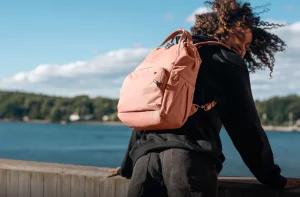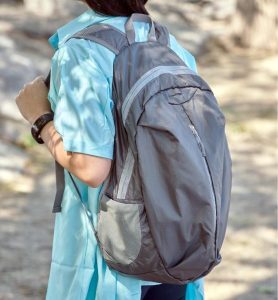Trekking poles are valuable accessories that provide stability, balance, and support during outdoor adventures. When not in use, it’s important to have a convenient way to carry them without hindering your movement. Attaching trekking poles to your backpack is an effective solution, allowing you to keep your hands free while keeping the poles accessible when needed. In this article, we will explore various methods how to attach trekking pole to backpack and provide a step-by-step guide to help you secure them properly.
Introduction
Importance of Trekking Poles

Trekking poles offer numerous benefits, especially during challenging terrains or long hikes. They help reduce stress on joints, provide stability on uneven surfaces, improve balance, and increase overall endurance.
By engaging your upper body, trekking poles also help distribute the workload more evenly, reducing fatigue and minimizing the risk of injuries.
Benefits of Attaching Trekking Poles to a Backpack
Attaching your trekking poles to your backpack ensures easy access and prevents the hassle of carrying them separately.
When not in use, having your trekking poles securely fastened to your backpack keeps your hands free from other tasks like taking photos, checking maps, or scrambling over obstacles. It also reduces the chances of misplacing or losing your trekking poles during your adventure.
Hands-Free Convenience: Attaching your trekking poles to your backpack allows you to have your hands free for other tasks. Whether you need to take photos, consult a map, or grab a snack, you can do so without having to hold onto your poles.
Easy Access: By keeping your trekking poles attached to your backpack, you can quickly retrieve them when needed. This is especially useful when encountering challenging terrain or when transitioning between different hiking conditions.
Reduced Fatigue: Trekking poles help distribute the workload and reduce stress on your joints, particularly during steep ascents and descents. When your poles are easily accessible on your backpack, you can use them as needed to maintain stability and alleviate strain, ultimately reducing fatigue.
Different Methods to Attach Trekking Poles to a Backpack
There are several methods you can use to attach your trekking poles to your backpack, depending on the design and features of your backpack. Here are five common methods:
Method 1: External Loops or Straps
Many backpacks come with external loops or straps specifically designed to secure trekking poles. These loops are typically made of webbing and are located near the bottom or sides of the backpack.
To attach your trekking poles using this method, simply slide the poles through the loops and adjust the straps to ensure a secure fit.
Method 2: Compression Straps
Compression straps are commonly found on backpacks and are used to compress the load and stabilize the contents. They can also double as attachment points for trekking poles.
To utilize this method, loosen the compression straps slightly, slide the poles beneath them, and tighten the straps to secure the poles in place.
Method 3: Bungee Cords or Shock Cords
Some backpacks feature bungee cords or shock cords that can be used to attach various gear, including trekking poles. These elastic cords usually have toggles or hooks at the ends. To attach your poles, hook the cords around the pole shafts and secure them in place using the toggles or hooks.
Method 4: Dedicated Trekking Pole Attachments
Certain backpacks are equipped with dedicated trekking pole attachments, which are specifically designed to hold the poles securely. These attachments often consist of adjustable straps or sleeves that slide over the poles and fasten them tightly to the backpack. Refer to your backpack’s user manual for instructions on using these attachments effectively.
Method 5: DIY Solutions
If your backpack doesn’t have built-in attachments for trekking poles, you can get creative and devise your own solutions. This might involve using carabiners, Velcro straps, or additional webbing to secure the poles to the backpack. DIY solutions allow for customization and adaptability based on the specific design of your backpack.
Attaching Trekking Poles to a Backpack

To attach your trekking poles to your backpack securely, follow these step-by-step instructions:
Step 1: Prepare your Backpack
Ensure your backpack is organized and the main compartment is accessible. This will make it easier to attach the trekking poles and distribute the weight evenly.
Choose a suitable backpack: Select a backpack that is compatible with attaching trekking poles. Look for backpacks that have dedicated attachment points or loops designed specifically for this purpose.
Empty your backpack: Start by emptying your backpack completely. Remove all items and gear to make it easier to work with.
Clean and organize: Take this opportunity to clean your backpack if needed. Remove any dirt, debris, or leftover items. Organize the main compartment and pockets to create space for the attachment.
Step 2: Choose the Attachment Method
Consider the attachment methods available based on your backpack’s design and features. Determine which method will work best for your needs and the specific trekking poles you are using.
Step 3: External Loops or Straps Method
If your backpack has external loops or straps, locate them and slide the trekking poles through the loops. Adjust the straps to achieve a snug fit that holds the poles securely in place.
Step 4: Compression Straps Method
Loosen the compression straps on your backpack slightly. Slide the trekking poles beneath the straps and tighten them to compress the load and secure the poles.
Step 5: Bungee Cords or Shock Cords Method
Identify the bungee cords or shock cords on your backpack. Hook them around the trekking pole shafts and secure them in place using the toggles or hooks.
Step 6: Dedicated Trekking Pole Attachments Method
If your backpack has dedicated trekking pole attachments, follow the instructions provided by the manufacturer to slide the poles into the attachments and secure them tightly.
Step 7: DIY Solutions Method
If none of the previous methods are applicable to your backpack, get creative and devise your own solution using carabiners, Velcro straps, or additional webbing. Ensure the poles are securely fastened and won’t come loose during your trek.
Improved convenience and accessibility: By securing the trekking poles to the backpack, they are always within reach, eliminating the need to stow them separately. This ensures quick access whenever required, such as during steep ascents or descents.
Reduced fatigue and increased stability: When not in use, trekking poles can cause fatigue if carried for extended periods. Attaching them to the backpack reduces this strain, allowing hikers to conserve energy. Additionally, having the poles readily available enhances stability on challenging terrains.
Freeing up hands for other tasks: Hikers often need their hands for various activities, such as taking photographs, using binoculars, or simply enjoying a snack on the trail. By attaching trekking poles to the backpack, hikers can have their hands free while maintaining easy access to the poles when needed.
Tips for Attaching Trekking Poles Securely

To ensure your trekking poles remain securely attached to your backpack, consider the following tips:
Tip 1: Ensure Proper Balance and Weight Distribution
When attaching trekking poles, distribute their weight evenly on both sides of your backpack. This helps maintain balance and prevents the backpack from leaning to one side.
Tip 2: Double-Check Attachment Points
Before setting off on your trek, double-check the attachment points to ensure they are secure and the poles won’t slide out accidentally.
Tip 3: Use Additional Securing Measures
For added peace of mind, you can use supplementary securing measures such as additional straps, carabiners, or tape to reinforce the attachment points and prevent any potential slippage.
Tip 4: Regularly Inspect and Adjust Attachments
During your trek, periodically check the attachments to ensure they haven’t come loose or shifted. Make any necessary adjustments to maintain a secure attachment.
FAQs
Can I attach trekking poles to any backpack?
Most backpacks have attachment points or methods that can be used to attach trekking poles. However, it’s always advisable to check the backpack’s design and features to ensure compatibility with the trekking pole attachment.
Do I need special attachments for trekking poles?
While some backpacks come with dedicated trekking pole attachments, it’s not necessary to have specialized attachments. You can use alternative methods such as external loops, compression straps, or DIY solutions to secure your trekking poles.
How do I know if the attachment is secure?
Ensure the attachment points are tightened properly and perform a few gentle tugs on the poles to check their stability. If they feel secure and don’t move or slide easily, the attachment is likely secure.
Are there any alternatives to attaching trekking poles to a backpack?
If attaching trekking poles to your backpack is not feasible or comfortable for you, you can consider using a dedicated trekking pole holder that attaches to your belt or waist strap.
Can I attach trekking poles to a daypack?
Some daypacks come with attachment points for trekking poles, while others may not. It’s best to check the features of your daypack and explore alternative methods, such as using carabiners or straps, to attach the poles securely.
Conclusion
Attaching trekking poles to your backpack is a practical solution that keeps your hands free while ensuring easy access to your poles whenever needed. By utilizing the various attachment methods available, such as external loops or straps, compression straps, bungee cords or shock cords, dedicated attachments, or DIY solutions, you can securely fasten your trekking poles and enjoy a more convenient hiking experience.

